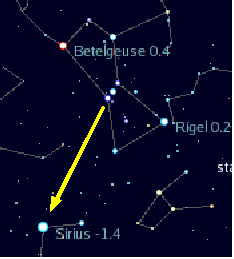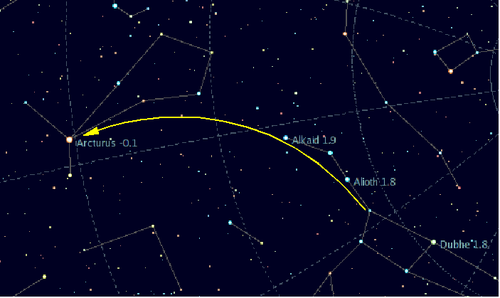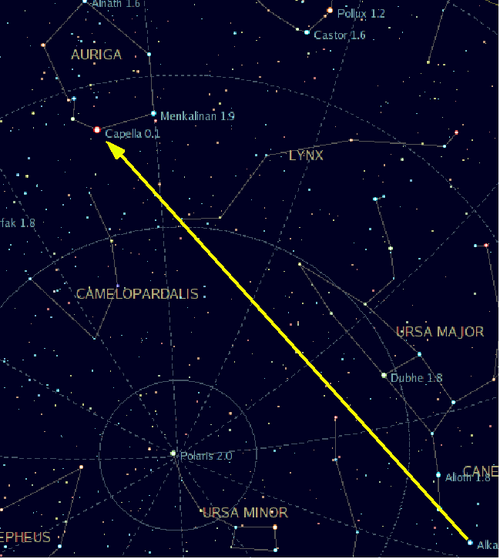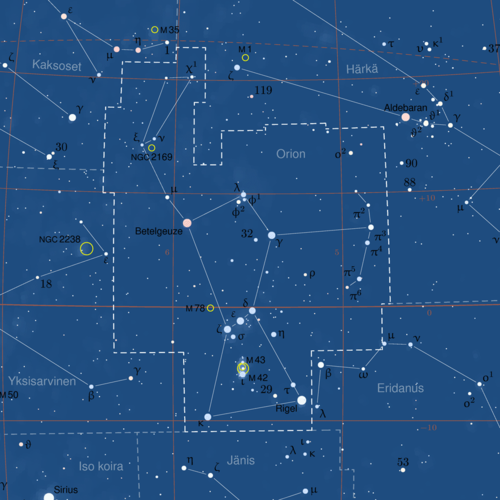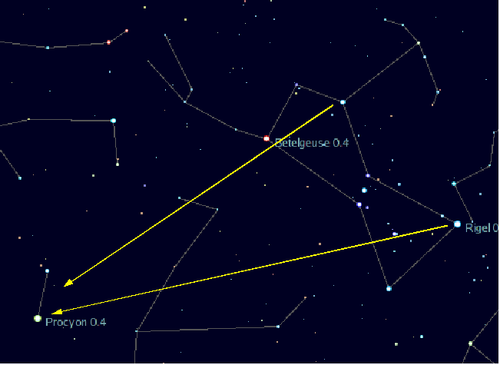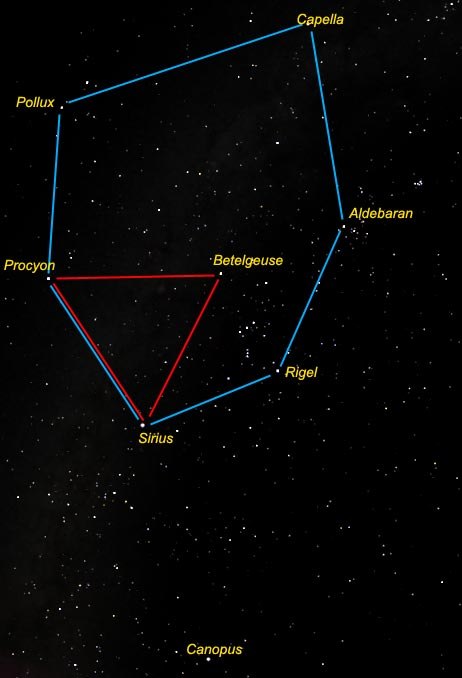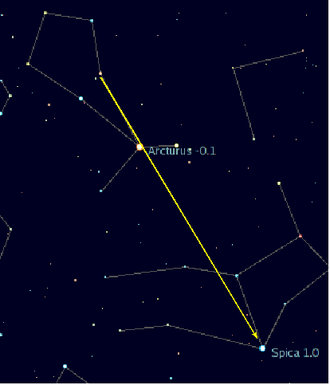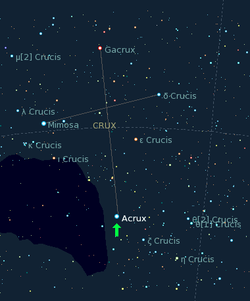Especialidades JA/Cosmografía - Avanzado/Respuestas 2
| Cosmografía - Avanzado | ||
|---|---|---|
| División Norteamericana
|
Destreza: 3 Año de introducción: 1949 |
|
Requisitos
Para consejos e instrucciones, véase Cosmografía.
La esfera celeste es una esfera imaginario en rotación de un «radio gigantesco», con la Tierra en el centro. Todos los objetos en los cielos pueden ser considerados como si estuvieran recostados sobre esta esfera.
Los dos polos celestes son los puntos imaginarios donde el eje de rotación de la Tierra intersecta la esfera celeste. El polo celeste al norte actualmente tiene casi las mismas coordenadas que la estrella brillante de Polaris (que en latín significa «Estrella Polar»).
El ecuador celeste es un círculo máximo de la esfera celeste imaginaria, que es en realidad el plano del ecuador terrestre extendido hacia el universo (es decir, podría ser construido mediante la extrapolación del ecuador de la Tierra hasta que toque la esfera celeste).
El horizonte es la línea que separa la tierra del cielo.
Right Ascension is the astronomical term for one of the two coordinates of a point on the celestial sphere when using the equatorial coordinate system. It is equivalent to terrestrial longitude.
Declination is one of the two coordinates of the equatorial coordinate system, the other being either right ascension or hour angle. Dec is comparable to latitude, projected unto the celestial sphere, and is measured in degrees north and south of the celestial equator. Therefore, points north of the celestial equator have positive declination, while those to the south have negative declination.
A transit is the astronomical event that occurs when one celestial body appears to move across the face of another celestial body, as seen by an observer at some particular vantage point.
Conjunction means that, as seen from some place (usually the Earth), two celestial bodies appear near one another in the sky.
The Ecliptic is the apparent path of the Sun traced out along the sky in the course of the year. More accurately, it is the intersection of the celestial sphere with the ecliptic plane, which is the geometric plane containing the mean orbit of the Earth around the Sun.
The constellations that can be seen all night in each hemisphere are the ones near the celestial poles.
Adventist Youth Honors Answer Book/Stars/Constellations visible all night
Northern Hemisphere:
In the east you should be able to find Cygnus (the Northern Cross) and Aquila. Directly overhead you should see Lyra. To the west you should be able to find Virgo, Leo, and Bootes.
Southern Hemisphere: In the east you should be able to find Aquila, Capricorn, and Sagitarius. Directly overhead you should see Scorpius. To the southwest you should be able to find Crux (the Southern Cross) and Centaurus.
Northern Hemisphere: To the south you should be able to see Orion, Canis Major, Canis Minor, Gemini, and Auriga.
Southern Hemisphere: In the east you should be able to find Canis Major, and Canis Minor. In the north you should see Orion. To the west you should be able to find Cetus and Fornax.
Orion is best seen in the winter because it is then visible just after sunset, and throughout most of the night. In the Northern Hemisphere the winter sky is generally clearer than the summer sky. The three brightest stars in Orion are Rigel (right foot), Betelguese (left shoulder), and Bellatrix (right shoulder).
The brightest star in a constellation is called alpha plus the constellation name. The second brightest is named beta, the third brightest is named gamma, and so forth. The best known example of this is Alpha Centauri which is the brightest star in the constellation Centaur. However, Alpha Centauri is actually a binary star, so the first two stars in our list can be Alpha Centauri A, and Alpha Centauri B. Acrux, Becrux, and Gacrux are the three brightest stars in Crux, the Southern Cross, and are so named as an abbreviation of Alpha-Crux, Beta-Crux, and Gamma-Crux.
First-magnitude stars in the Northern Hemisphere
Sirius
Sirius is the brightest star in the night-time sky, with a visual apparent magnitude of −1.46. It is located in the constellation Canis Major. As the major star of the "Big Dog" constellation, it is often called the "Dog Star". Sirius can be seen from every inhabited region of the Earth's surface. At a distance of 2.6 pc or 8.57 light years, Sirius is also one of the nearest stars to Earth. The best time of year to view it is around January 1, when it reaches the meridian at midnight. Sirius can be found by following Orion's belt from the viewer's right to left.
Arcturus
Arcturus is the brightest star in the constellation Boötes, and the third brightest star in the night sky, with a visual magnitude of −0.05, after Sirius and Canopus. Arcturus can be found by following the arc made by handle of the Big Dipper (away from the dipper's bowl).
Vega and Altair
Vega is the brightest star in Lyra, and the fifth brightest star in the sky. It is the third brightest star in the Northern night sky, after Sirius and Arcturus, and can often be seen near the zenith in the mid-northern latitudes during the Northern Hemisphere summer.
Vega is a vertex of the Summer Triangle, which consists of Vega (in Lyra), Deneb (in Cygnus) and Altair (in Aquila). If one is to consider this asterism a right triangle, then Vega would correspond to its right angle. This triangle is very recognisable in the northern skies for there are few bright stars in its vicinity.
Altair is the brightest star in the constellation Aquila and the twelfth brightest star in the nighttime sky, at visual magnitude 0.77. Like Vega, it is a member of the Summer Triangle.
Capella
Capella is the brightest star in the constellation Auriga and sixth brightest star in the sky. Although it appears as a single point to the naked eye, Capella is actually a bright close binary pair of stars along side a second, fainter binary. Capella can be found by following the line made by the two stars in the Big Dipper's handle and extending it across the Dipper's bowl.
Rigel and Betelguese
Rigel is the brightest star in the constellation Orion and the seventh brightest star in the sky, with visual magnitude 0.12. Rigel is Orion's left foot.
Betelguese is the second brightest star in the constellation Orion, and the tenth brightest star in the night sky. Betelguese is Orion's right shoulder. Betelgeuse is a red supergiant, one of the physically largest stars known. If it were placed at the center of our solar system, its outer surface would possibly extend to the orbit of Mars.
Procyon
Procyon is the brightest star in the constellation Canis Minor and the eighth brightest star in the nighttime sky. It can be found using stars in Orion in two different ways:
- By following Orion's left foot (Rigel) through the tip of his sword.
- By following Bellatrix (his left shoulder) through Betelguese (his right shoulder).
Procyon, Sirius, and Betelguese also form an equilateral triangle.
Aldebaran
Once you can find Rigel, Sirius, Procyon, and Capella, finding Aldebaran is easy, for these five stars, plus Pollux make up the Winter Circle.
Spica
Spica is the brightest star in the constellation Virgo, and the 15th brightest star in the sky. It can be found by following a line starting at the star ρ Boötis, and continuing through Arcturus to Spica.
First-magnitude stars in the Southern Hemisphere
Canopus
Canopus is the brightest star in the southern constellation of Carina, and the second brightest star in the sky, with a visual magnitude of −0.62, second only to Sirius. Canopus is a yellowish-white supergiant star. It is located well into the southern hemisphere, at a declination of −52° 42' (2000) and a right ascension of 06h24.0m, and is visible on the southern horizon of even the southern US States as far north as Virginia or Kentucky. That far north, it can only be seen on a very clear night during the last two weeks of February directly south very low on the horizon just after sunset.
Alpha Centauri A and Hadar
Alpha Centauri A is located in the Southern Hemisphere, and can only be seen in the United States from points south of Daytona Beach, Florida or San Antonio, Texas. Even then, it barely rises above the horizon directly to the South for a few days around July 8.
Hadar is also known as Beta Centauri, for it is the second brightest star in the constellation Centaurus. It is just to the West of Alpha Centauri A, so if you can see the one, you can probably see the other.
Achernar
Achernar is located in the Southern Hemisphere, and therefore is never visible in most of North America. It can be seen from Dallas Texas and points south in mid to late November due South, and very low on the horizon.
Acrux
Acrux is the brightest star in constellation Crux (the Southern Cross) and the thirteenth brightest star in the nighttime sky, at visual magnitude 0.77. Acrux is represented in the flag of Australia as one of the 5 stars that comprise the Southern Cross. Since Acrux is at roughly −60° declination, it is generally only visible south of the Tropic of Cancer and therefore didn't receive an ancient traditional name; "Acrux" is simply a combination of the A in Alpha plus Crux (meaning "cross"). Acrux is the southernmost first magnitude star, just a bit more southerly than Alpha Centauri. Acrux can be seen as far north as Miami, Florida, but it only barely rises above the horizon. You might be able to see it due south around May 8 (any year) at about 9:00 pm. If you wait around until midnight, Alpha Centauri and Hadar will also be visible around that date as well (also directly to the south and just over the horizon).

Since the Earth's crust is solid, it moves, along with everything inside it, as one whole, as defined by the average force on it. For the Earth's shape this average force is equal to the force on its center. The water at the surface is free to move following forces on its particles. One of the forces that affects tides is the gravity of the Moon. The force of gravity gets weaker as the distance between two bodies increases, and since the center of the Earth is farther away than the surface nearest the Moon, the Moon's gravity pulls on the surface water stronger than it pulls on the whole of the Earth. This causes the water level to rise and causes a high tide.
Meanwhile, on the side of the Earth opposite the Moon, the surface is farther from the moon than the Earth's center, so the Moon pulls more strongly on the Earth as a whole than it does on the water. This causes the water move away from the Moon, but since this is on the other side of the Earth, the water level still rises, causing a high tide.
Low tides occur at the points on the Earth where the Moon is just rising or just setting - that is, where the surface is at a 90° angle from the moon.
The Sun also has a tidal effect, but since it is much farther away, the difference between the pull of gravity at the surface of the Earth and the pull of gravity at the center is much smaller as compared to the Moon. When the tidal action caused by the Sun and Moon reinforce one another we have a spring tide (which is higher than normal). When they oppose one another, we have a neap tide (which is also a high tide, but lower than normal).
- Job 9:9 (21st Century King James Version)
- "Who maketh Arcturus, Orion and Pleiades, and the chambers of the south;"
- Job 38:31,32 (21st Century King James Version)
- "Canst thou bind the sweet influences of Pleiades, or loose the bands of Orion? Canst thou bring forth Mazzaroth in his season? Or canst thou guide Arcturus with his sons?"
- Amos 5:8 (NIV)
- "He who made the Pleiades and Orion, who turns blackness into dawn and darkens day into night, who calls for the waters of the sea and pours them out over the face of the land— the LORD is his name."
Most English versions of the Bible translate Arcturus as The Bear.
References
- Wikipedia articles:
- Categoría: Tiene imagen de insignia
- Adventist Youth Honors Answer Book/Honors/es
- Adventist Youth Honors Answer Book/es
- Adventist Youth Honors Answer Book/Skill Level 3/es
- Categoría: Libro de respuestas de especialidades JA/Especialidades introducidas en 1949
- Adventist Youth Honors Answer Book/North American Division/es
- Adventist Youth Honors Answer Book/Nature/es
- Adventist Youth Honors Answer Book/Nature/Primary/es
- Adventist Youth Honors Answer Book


